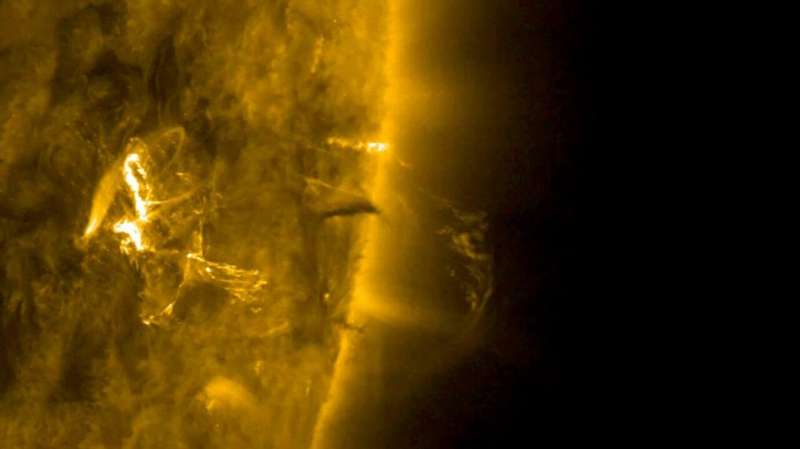The solar wind, explained

The solar wind is a flow of particles that comes off the sun at about one million miles per hour and travels throughout the entire solar system. First proposed in the 1950s by University of Chicago physicist Eugene Parker, the solar wind is visible in the halo around the sun during an eclipse and sometimes when the particles hit the Earth’s atmosphere—as the aurora borealis, or northern lights.
While the solar wind protects Earth from other harmful particles coming from space, storms can also threaten our satellite and communications networks.
What is the solar wind?
The surface of the sun is blisteringly hot at 6,000 degrees Fahrenheit—but its atmosphere, called the corona, is more than a thousand times hotter. It is also incredibly active; those flares and loops are the halo you see around the sun when there’s an eclipse.
The corona is so hot that the sun’s gravity can’t hold it, so particles are flung off into space and travel throughout the solar system in every direction. As the sun spins, burns and burps, it creates complex swirls and eddies of particles. These particles, mostly protons and electrons, are traveling about a million miles per hour as they pass Earth.
This flow of particles, called the “solar wind,” has an enormous impact on our lives. It protects us from stray cosmic rays coming from elsewhere in the galaxy—but the effects of storms on the sun’s surface can also affect our telecommunications networks. The wind would also pose a threat to astronauts traveling through space, so NASA wants to get a better understanding of its properties.
How was the solar wind discovered?
Credit: NASA
In 1957, Eugene Parker was an assistant professor at the University of Chicago when he began looking into an open question in astrophysics: Are particles coming off of the sun? Such a phenomenon seemed unlikely; Earth’s atmosphere doesn’t flow out into space, and many experts presumed the same would be true for the sun. But scientists had noticed an odd phenomenon: The tails of comets, no matter which direction they traveled, always pointed away from the sun—almost as though something was blowing them away.
Parker began to do the math. He calculated that if the sun’s corona was a million degrees, there had to be a flow of particles expanding away from its surface, eventually becoming extremely fast—faster than the speed of sound. He would later name the phenomenon the “solar wind.”
“And that’s the end of the story, except it isn’t, because people immediately said, “I don’t believe it,'” Parker said.
He wrote a paper and submitted it to the Astrophysical Journal; the response from scientific reviewers was swift and scathing.
“You must understand how unbelievable this sounded when he proposed it,” said Fausto Cattaneo, a UChicago professor of astronomy and astrophysics. “That this wind not only exists, but is traveling at supersonic speed! It is extraordinarily difficult to accelerate anything to supersonic speeds in the laboratory, and there is no means of propulsion.”
Luckily, the editor of the journal at the time was eminent astrophysicist Subrahmanyan Chandrasekhar, Parker’s colleague at the University of Chicago. Chandrasekhar didn’t like the idea either, but the future Nobel laureate couldn’t find anything wrong with Parker’s math, so he overruled the reviewers and published the paper.
Only three years later, when a NASA spacecraft called Mariner II took readings on its journey to Venus in 1962, the results were unambiguous. “There was the solar wind, blowing 24/7,” Parker said.
How does the solar wind effect us?
Credit: NASA
The breakthrough discovery reshaped our picture of space and the solar system. Scientists came to understand that the solar wind not only flows past Earth, but throughout the solar system and beyond. It also both protects and threatens us.
“The solar wind magnetically blankets the solar system, protecting life on Earth from even higher-energy particles coming from elsewhere in the galaxy,” explained UChicago astrophysicist Angela Olinto. “But it also affects the sophisticated satellite communications we have today. So understanding the precise structure and dynamics and evolution of the solar wind is crucial for civilization as a whole.”
Normally, Earth’s magnetic field shields us from most of these particles. But sometimes, the sun “burps,” throwing a billion tons of material into space flying at several thousand kilometers per second. These are called coronal mass ejections—and if a big one happened to hit Earth, the shockwave could cause chaos and damage to our communication systems. “It can cause the magnetic field that surrounds Earth to ring like a struck bell,” said Prof. Justin Kasper, a UChicago alum now a physicist at the University of Michigan. Such a scenario would generate all kinds of disturbances: Aircraft would lose radio communication, GPS would be thrown off by up to miles, and banking, communications and electronic systems could be knocked out.
This has actually happened before: In 1859, a giant solar eruption known as the Carrington Event shut down telegraph and electrical systems for days. The aurora borealis was so strong that people reported being able to read a newspaper by its light even at one o’clock in the morning. “There was a ghastly splendor over the horizon of the North, from which fantastic spires of light shot up, and a rosy glow extended, like a vapor tinged with fire, to the zenith,” wrote the Cincinnati Daily Commercial.
But in 1859, we weren’t as reliant on electronics as we are today. A 2013 study by Lloyd’s of London estimated that a similar storm hitting Earth today could cause up to $2.6 trillion in damages to the United States alone, and would trigger widespread blackouts and damages to electrical grids.
There are some precautions we could take if we had advance notice, which is why engineers want to know when a solar storm is incoming. Luckily, several spacecraft orbiting the sun take pictures and send them back to Earth so that NASA can monitor for eruptions. (You can see current space weather conditions here.) But analyzing these images still requires an eruption to first show up on the sun’s surface, which only provides minutes or hours of warning. As of now, there still isn’t way to predict such eruptions before they happen.
A better understanding of the solar wind also factors into another human venture: space travel. Some solar wind particles are extremely energetic, and could poke tiny holes through important spacecraft equipment—not to mention human bodies. In order to protect astronauts, NASA needs to understand the components, characteristics, and frequencies of such particles, as well as how to forecast space weather in advance for safe journeys.
What mysteries remain about the solar wind?
An artist’s rendering of the solar wind particles coming towards Earth. Credit: NASA
One of the biggest problems facing space weather forecasters is that we still don’t know why the atmosphere of the sun is so much hotter than the surface.
In everyday life, you’d expect the temperature to decrease steadily as you get further away from a heat source, like moving your hand away from a fire. But that’s not what happens on the sun. In this case, the heat comes from fusion happening in the sun’s core, which gradually cools to 6,000 degrees Fahrenheit at the surface—then shoots up again to millions of degrees in the corona.
Many theories have been proposed. Scientists know that the entire surface of the sun is constantly churning and erupting; perhaps there are smaller “nanoflares” (each still packing the energy of a 10-megaton hydrogen bomb) constantly erupting all over the sun’s surface that carry heat to the atmosphere. There are also magnetic fields interacting at the sun’s surface; it’s possible these magnetic fields are hitting each other with explosive force billions of times per second—”canceling” each other out, but heating the atmosphere in the process.
Questions that scientists would like to answer include:
Why is the corona so much hotter than the surface of the sun? How does the solar wind accelerate away from the sun?
How fast are the particles moving, and how hot are they getting?
Are magnetic fields heating the particles, or are there mechanical waves coming from the surface of the sun? (or both?)
A deeper understanding of these processes could help forecast space weather that affects life on Earth, reveal more about the conditions that astronauts in orbit above our world and journeying for long distances would face, and even provide clues about what kinds of star activity might favor habitability on distant planets.
But to get answers, we need to get close to the sun itself.
What is NASA’s Parker Probe?
This combination of three wavelengths of light from NASA’s Solar Dynamics Observatory led to a series of slow coronal puffs on Jan. 17, 2013. Credit: NASA
Scientists have been eager for a mission to the sun since space travel first became possible. Not only is the sun vital to life on Earth, it is also by far the closest star we can study. But the extreme temperatures meant that scientists needed to wait for the development of technology that could shield the spacecraft from the intense heat and radiation of the sun.
In 2018, this dream finally came true. NASA’s Parker Solar Probe—named for Eugene Parker in honor of his pioneering research—began a seven-year journey to the blisteringly hot corona of the sun on Aug. 12, 2018. The probe is the fastest-moving object built by humans, traveling at more than 150,000 miles per hour. It’s so fast that it’s already made several trips around the sun.
The probe’s heat shield, made of just under five inches of a cutting-edge carbon composite, keeps the craft’s delicate instruments at a cool 85 degrees Fahrenheit, even as the corona rages at 3,000,000 degrees outside. (Except for one especially tough instrument, built by UChicago alum Justin Kasper, which peeks around the edge of the craft to scoop up particles of the solar wind).
The probe has already sent huge amounts of data back to Earth, which led to discoveries such as bizarre “switchbacks” in the solar wind.
Parker, then 91, flew to Cape Canaveral with his family to watch the NASA spacecraft launch.
“So much has gone into this launch, and then to see it all disappear slowly—fading away into the night sky, knowing it will never come back—it was a moving experience,” Parker said. “You rarely have a space mission that doesn’t come up with the unexpected, and it’s actually going to get more exciting as the mission goes on and crosses into regions that spacecraft have never been in before. It’s just fascinating every step of the way.”



 Creators of mankind
Creators of mankind Description of “Tall white aliens”
Description of “Tall white aliens” Where they came from?
Where they came from? About hostile civilizations
About hostile civilizations The war for the Earth
The war for the Earth “Tall white aliens” about eternal life
“Tall white aliens” about eternal life Video: “Nordic aliens”
Video: “Nordic aliens” Aliens
Aliens Alien encounters
Alien encounters The aliens base
The aliens base UFO
UFO Technology UFO
Technology UFO Underground civilization
Underground civilization Ancient alien artifacts
Ancient alien artifacts Military and UFO
Military and UFO Mysteries and hypotheses
Mysteries and hypotheses Scientific facts
Scientific facts


















